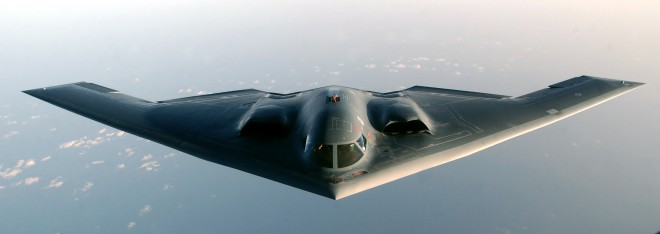Oracle
New Member
- Joined
- Mar 31, 2010
- Messages
- 8,120
- Likes
- 1,566

Photo: B-2 stealth bomber (U.S. Air Force)
It's been a pillar of the U.S. military's approach to high-tech warfare for decades. And now, it could be become obsolete in just a few years.
Stealth technology — which today gives U.S. jets the nearly unparalleled ability to slip past hostile radar — may soon be unable to keep American aircraft cloaked. That's the potentially startling conclusion of a new report from Barry Watts, a former member of the Pentagon's crystal-ball-gazing Office of Net Assessment and current analyst with the Center for Strategic and Budgetary Assessments in Washington.
"The advantages of stealth "¦ may be eroded by advances in sensors and surface-to-air missile systems, especially for manned strike platforms operating inside defended airspace," Watts cautions in his 43-page report The Maturing Revolution in Military Affairs (.pdf), published last week.
That could come as a big shock to the U.S. Air Force, which has bet its future on radar-dodging technology, to the tune of half-a-trillion dollars over the next 30 years. The Navy, on the other hand, might have reason to say, "I told you so."
That is, if Watts' prediction comes true — and that's a big "if," the analyst admits.
"In recent years there has been speculation that ongoing advances in radar detection and tracking will, in the near future, obviate the ability of all-aspect, low-observable aircraft such as the B-2, F-22 and F-35 Joint Strike Fighter, aka JSF, to survive inside denied airspace," Watts writes, referring to America's stealth bombers and fighter jets.
Stealth-killing advances include VHF and UHF radars being developed by Russia and China, and a "passive-detection" system devised by Czech researchers. The latter "uses radar, television, cellular phone and other available signals of opportunity reflected off stealthy aircraft to find and track them," Watts explains.
These new detection systems could reverse a 30-year trend that has seen the U.S. Air Force gain an increasing advantage over enemy defenses. That phenomenon began with the introduction of the F-117 stealth fighter in the late 1980s, followed by the addition of the stealthy B-2 (pictured) in the '90s and, more recently, the F-22.
So far, the Air Force has only ever fielded a few hundred stealth aircraft, requiring it to constantly upgrade some nonstealthy fighters. But the flying branch plans to purchase more than 1,700 F-35s (at more than $100 million a pop) from Lockheed Martin in coming decades, plus up to 100 new stealth bombers. In that sense, the stealth era is only now truly dawning — just as effective counter-measures are nearly ready, Watts points out.
In that sense, the Air Force's stealth gamble could turn into very, very long odds.
Comparatively, the Navy has played it safe. At the same time the Air Force was investing its research and development dollars in stealth, the Navy has taken a different approach to defeating enemy defenses. Where the Air Force plans to slip past radars, the Navy means to jam them with electronic noisemakers or destroy them with radar-seeking missiles. That's why the only radar-killing planes in the Pentagon inventory belong to the Navy — and why, until the forthcoming F-35C, the Navy has never bought a stealth fighter.
Nowhere is that philosophical difference more apparent than in the Pentagon's on-again, off-again effort to develop jet-powered killer drones. The Navy's X-47 drone, built by Northrop, is minimally stealthy. Boeing's Phantom Ray, intended mostly for Air Force programs, is arguably as stealthy as an F-35 in certain scenarios.
There's still a chance the Air Force's bet on stealth could pay off, Watts writes. That largely depends on two capabilities planned for the F-35.
First, there's "the JSF's sensor suite and computational power," which Watts explains "can be easily upgraded over time due to the plane's open avionics architecture, giv[ing] the F-35 an ability to adjust its flight path in real time in response to pop-up threats, something neither the F-117 nor the B-2 have been able to do."
Second, the F-35's radar, a so-called "electronically scanned array," could in theory be used to jam an enemy radar or even slip malicious software code into its control system.
Neither of these capabilities is actually a form of stealth, per se. Rather, they would complement the F-35's ability to absorb or deflect radar waves. Described uncharitably, the Air Force has had to add nonstealthy skills to its stealth fighters, just to help them survive.
Watts doesn't address one other way the Air Force could preserve its stealth advantage: by speeding up the development of drone aircraft — which, by virtue of their smaller size, have the potential to be much stealthier than any manned aircraft.
It's also worth noting that America's biggest rivals don't doubt the continuing relevance of stealthy planes. Russia and China have both unveiled new stealth-fighter prototypes in the last two years.
The way Watts describes it, the "end of stealth" is just one of the many big changes that could occur in near-future warfare — big emphasis on "could." "The honest answer to the question about how fundamentally war's conduct will change — and how soon — remains: It depends."
Wired

